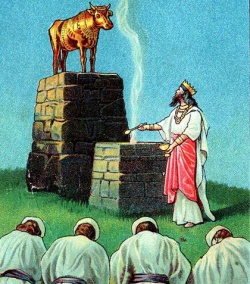Difference between revisions of "Idolatry"
(Created page with "thumb|250px| Idolatry (''paṭimāpūjā'') is the practice of worshipping and praying to statues, regarding them to be God or some revered person. Wh...") |
|||
| (3 intermediate revisions by the same user not shown) | |||
| Line 1: | Line 1: | ||
[[File:Idolatry.jpg|thumb|250px|]] | [[File:Idolatry.jpg|thumb|250px|]] | ||
| − | Idolatry (''paṭimāpūjā'') is the practice of | + | [[Idolatry]] (''[[paṭimāpūjā]]'') is the practice of worshiping and praying to [[statues]], regarding them to be [[God]] or some revered [[person]]. While [[statues]] are used in some [[Buddhist]] [[pūjās]], no informed [[Buddhist]] believes them to be the [[Buddha]] himself, nor do they ‘pray’ to these [[statues]]. In the 7th century the {{Wiki|Chinese}} [[monk]] [[I-tsing]] wrote: ‘Although the [[Great Teacher]] has [[attained]] [[Nirvāṇa]], images of him still [[exist]]. These can be venerated as if he were still in the [[world]].’ No one who has made even the slightest [[effort]] to understand [[Buddhism]] or [[Buddhist]] [[rituals]] could believe that [[Buddhists]] are idolaters. |
| + | |||
| + | And, of course, there have been [[people]] who have made an [[effort]] to understand. A {{Wiki|Muslim}} work called Dabistan al-Madhhāhib composed in [[India]] in the late 15th century says: ‘Strangers to their ([[Buddhists]]’ and [[Hindus]]’ ) [[faith]] might think that they look upon the statue as the [[deity]] but this is certainly not the case. This is what they believe – that the statue is only a [[representation]] of the [[deity]], for the [[deity]] itself has neither shape nor [[form]].’ | ||
| + | |||
| + | The English {{Wiki|Christian}} Robert Knox who spent many years living in [[Sri Lanka]] in the 17th century wrote this of the {{Wiki|Sinhalese}} [[attitude]] to [[Buddha statues]]: ‘As for these images, they say they do not own them to be [[Gods]] themselves but only Figures representing their [[Gods]] to their {{Wiki|memories}}, and as such, they give them {{Wiki|honor}} and {{Wiki|worship}}.’ Those today who continue to insist that [[Buddhism]] is a [[form]] of [[idolatry]] are guilty of either willful [[ignorance]] or deliberate [[dishonesty]]. | ||
{{R}} | {{R}} | ||
[http://www.buddhisma2z.com/content.php?id=185 www.buddhisma2z.com] | [http://www.buddhisma2z.com/content.php?id=185 www.buddhisma2z.com] | ||
[[Category:Buddhist Terms]] | [[Category:Buddhist Terms]] | ||
Latest revision as of 00:58, 19 March 2014
Idolatry (paṭimāpūjā) is the practice of worshiping and praying to statues, regarding them to be God or some revered person. While statues are used in some Buddhist pūjās, no informed Buddhist believes them to be the Buddha himself, nor do they ‘pray’ to these statues. In the 7th century the Chinese monk I-tsing wrote: ‘Although the Great Teacher has attained Nirvāṇa, images of him still exist. These can be venerated as if he were still in the world.’ No one who has made even the slightest effort to understand Buddhism or Buddhist rituals could believe that Buddhists are idolaters.
And, of course, there have been people who have made an effort to understand. A Muslim work called Dabistan al-Madhhāhib composed in India in the late 15th century says: ‘Strangers to their (Buddhists’ and Hindus’ ) faith might think that they look upon the statue as the deity but this is certainly not the case. This is what they believe – that the statue is only a representation of the deity, for the deity itself has neither shape nor form.’
The English Christian Robert Knox who spent many years living in Sri Lanka in the 17th century wrote this of the Sinhalese attitude to Buddha statues: ‘As for these images, they say they do not own them to be Gods themselves but only Figures representing their Gods to their memories, and as such, they give them honor and worship.’ Those today who continue to insist that Buddhism is a form of idolatry are guilty of either willful ignorance or deliberate dishonesty.
